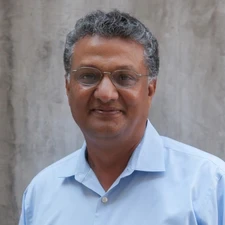Srinivas Bettadpur

The 2016 Vening Meinesz Medal is awarded to Srinivas Bettadpur in recognition of his outstanding contributions to precise orbit determination and ocean-tide modelling, and his pioneering developments in the field of time-variable gravity field determination from satellite-to-satellite tracking data.
The Gravity Recovery and Climate Mission (GRACE) launched in 2002 and presently expected to be operational through to 2016 or 2017, is arguably the most interdisciplinary Earth science satellite mission ever launched. It is certainly one of the most successful. GRACE provides monthly global maps of the Earth’s time-varying gravity field with unprecedented accuracy down to scales of a few hundred kilometres, which allows interdisciplinary studies of the redistribution of Earth’s mass related to hydrology, oceanography, glaciology, solid Earth and climate change. Investigations enabled by GRACE include the inference of large-scale groundwater changes, determining variations in sea-floor pressure and sea level, estimating changes in polar ice sheet masses, constraining models of Glacial Isostatic Adjustment and source parameters of large undersea earthquakes. The underpinning of all of this, of course, is satellite geodesy, and that’s where Srinivas Bettadpur comes in. He has played a major scientific role allowing the unprecedented accuracy achieved for routine monthly GRACE gravity solutions that fully exploit the micron-level inter-satellite tracking data. He has been a leader not only in the development of the overall design of the GRACE gravity solution effort within the mission’s Science Data System, but also in the day-to-day planning and management of the generation of the University of Texas GRACE data products. His primary technical achievements are in the area of orbital analysis, ocean-tide modelling and gravity field determination. He has an unusually deep understanding of how numerical procedures work for nonlinear orbit determination and parameter recovery, how different solution strategies and error sources can affect the answers, and of all the ways that can be applied to optimise the results in different situations. Additionally, he is one of very few people who understands all aspects of the GRACE mission, from the hardware to data analysis and to the scientific applications. He has also been able to draw on this to enhance the scientific interpretation of the solutions. In addition to his technical and scientific responsibilities, Bettadpur has been contributing to mission planning and decision making at all levels helping to increase the mission lifetime to beyond 13 years, a key prerequisite for the GRACE time series to be useful for climate-change studies. In large satellite mission implementations, it is often difficult for individuals to distinguish themselves, but Bettadpur is clearly recognised by the international community as a key contributor to the outstanding achievements of the GRACE mission. Furthermore, due to the recognised success of GRACE, US and Germany have jointly approved the GRACE Follow-On mission, scheduled for launch in 2017, which has an innovative laser ranging interferometer for improved inter-satellite tracking and respective higher accuracy temporal gravity models. Bettadpur is, again, deeply involved in designing the necessary scientific data analysis procedures for that mission.
